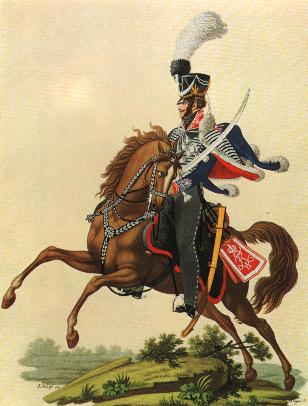
Prussian Hussars

Brandenburg Hussars charging at the Battle of Leipzig, 16 October 1813. Original painting by Prof Carl Röchling. Reproduced in Die Deutschen Befreiungskriege 1806-1815 by Prof Müller-Bohn, Published in 1900(?).
Introduction
Prussian Hussars were famous for their bravery. At the Battle of Heilsberg in 1807, the Prittwitz Hussars charged and captured the Eagle of the French 55th line infantry regiment. At the Battle of Leipzig in 1813, the Mecklenberg-Strelitz Hussars charged and captured the Eagle of the Marines of the Imperial Guard. We should also recall that the fiery Prussian Marshal Blücher - Marshal Vorwärts himself - started his career in the Prussian army as an hussar officer.
Organisation
1806 - 10 Hussar Regiments each of 10 squadrons. Total of around 150 officers and men per squadron.
1813 - 1814 - 6 Hussar Regiments each of 4 squadrons. Total of around 150 officers and men per squadron.
1815 - 7 Hussar Regiments each of 4 squadrons.
Uniforms
1806:
| Regt | Dolman | Facings | Cords/Buttons | Pelisse | Fur Trim (Officers) | (Men) | Sash Cords | Barrel Sash | Sabretasche | Trim |
| No 1 | dark green | red | white | dark green | white | white | red | white | dark green | white |
| No 2 | scarlet | dark blue | white/offrs gold | dark blue | grey | white | dark blue | white | red | white/offrs gold |
| No 3 | dark blue | yellow | yellow | dark blue | white | white | yellow | white | yellow | white |
| No 4 | light blue | red | blue&white/offrs silver | pale blue | white | white | yellow | white | white/offrs light blue | light blue/offrs silver |
| No 5 | black | scarlet | white | black | white | black | red | white | black/offrs red | none/offrs silver |
| No 6 | brown | yellow | yellow | brown | white | white | yellow | white | brown | yellow |
| No 7 | lemon yellow | light blue | white | light blue | black | black | light blue | white | light blue | white |
| No 8 | dark crimson | black | white | dark crimson | black | black | red | white | black | none/offrs silver |
| No 10 | dark blue | yellow | white | dark blue | white | black | crimson | blue | black/offrs blue | none/offrs silver |
| No 11 | dark green | scarlet | yellow | dark green | blue | white | red | white | red | yellow |
Note: The shako was introduced in 1804. By 1806, not all regiments had converted to the new headgear. Hence, some regiments wore mirletons while others wore shakos. White plumes for men / white with black base for officers. Regt no 5 wore a death's head badge on the front of their shakos.
1815:
| Regiment/Designation | Dolman & Pelisse | Collar & Cuffs | Buttons & Cords |
| Guard | dark blue | red with yellow trim | yellow |
| No 1 1st Leib Regt | black | red | white |
| No 2 2nd Leib Regt | black | black | white |
| No 3 Brandenburg | dark blue | red | white |
| No 4 1st Silesian | brown | yellow | yellow |
| No 5 Pomeranian | dark blue | dark blue | yellow |
| No 6 2nd Silesian | green | red | yellow |
| No 7 | black | red | yellow |
| No 8 | dark blue | light blue | white |
| No 9 | cornflower blue | cornflower blue | yellow |
| No 10 | green | light blue | yellow |
| No 11 | green | red | white |
| No 12 | cornflower blue | cornflower blue | white |
Notes:
Headgear was the shako. This was covered by an oilskin on campaign. Under the oilskin, the shako had a central black and white rosette (black and silver for officers). The 2 Life regiments had a white metal death's head badge. The Guard Hussars had a brass "guard" star badge (silver for officers). Just below the plume, a black and white cockade was worn. Troopers wore a long white plume on parade. Officers wore a long white plume with black base.
Pelisse fur was white for troopers and grey for officers. From 1815, black pelisse fur was also worn by both officers and troopers of the 2nd, 7th, 8th, 9th, 10th and 12th regiments.
Sash was in the facing colour with barrels in the button colour. Officers' sashes were silver and black.

Officer, Brandenburg Hussars, 1812

The famous Major von Schill at the head of the 2nd Brandenburg Hussars in 1809. The regiment was disbanded in 1809, after Schill's unsuccessful attempt to start an uprising in Northern Germany. This regiment wore the same uniform as the 1st Brandenburg Hussars except that shoulder straps were yellow.
Acknowledgement and Sources:
Peter Hofschröer and Bryan Fosten: Prussian Cavalry of the Napoleonic Wars Vols 1 and 2 (Osprey Men-at-Arms)
A Mila: Geschicte der Bekleidung und Ausrüstung der königlichen preussischen Armee
Liliane and Fred Funcken: Historische Uniformen
[an error occurred while processing this directive]